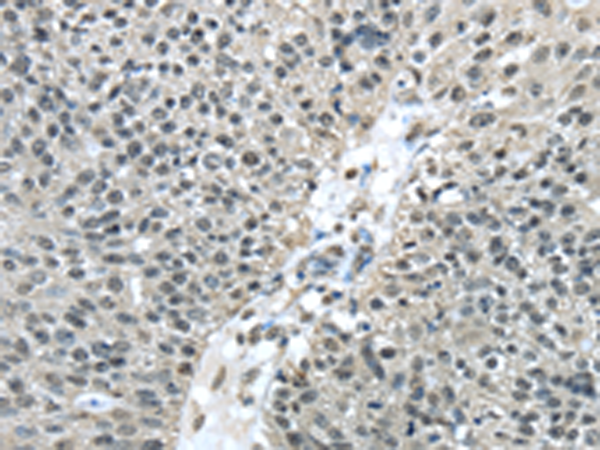
| WB | 咨询技术 | Human,Mouse,Rat |
| IF | 咨询技术 | Human,Mouse,Rat |
| IHC | 1/30-1/150 | Human,Mouse,Rat |
| ICC | 技术咨询 | Human,Mouse,Rat |
| FCM | 咨询技术 | Human,Mouse,Rat |
| Elisa | 1/2000-1/10000 | Human,Mouse,Rat |
| Aliases | TLS; ALS6; ETM4; FUS1; POMP75; HNRNPP2 |
| Host/Isotype | Rabbit IgG |
| Antibody Type | Primary antibody |
| Storage | Store at 4°C short term. Aliquot and store at -20°C long term. Avoid freeze/thaw cycles. |
| Species Reactivity | Human, Mouse |
| Immunogen | Fusion protein of human FUS |
| Formulation | Purified antibody in PBS with 0.05% sodium azide and 50% glycerol. |
+ +
以下是关于FUS抗体的3篇参考文献及其摘要概括:
---
1. **文献名称**: *FUS-immunogold microscopy reveals cytoplasmic and nuclear RNA granules in axonal processes*
**作者**: Fujioka Y. et al. (2021)
**摘要**: 该研究利用FUS特异性抗体结合免疫金标记技术,揭示了神经元轴突中FUS蛋白与RNA颗粒的共定位现象,表明FUS在轴突RNA运输及局部翻译中可能发挥关键作用,为神经退行性疾病中轴突功能障碍提供了新机制。
---
2. **文献名称**: *Distinct antibody-based validation of FUS truncations in ALS patient fibroblasts*
**作者**: López-Erauskin J. et al. (2020)
**摘要**: 通过开发针对FUS C端结构域的特异性抗体,研究者在ALS患者成纤维细胞中验证了FUS的C端截短突变体,证实其异常核质分布与细胞毒性相关,为基于抗体检测的疾病分型提供了工具。
---
3. **文献名称**: *Phase separation of FUS is modulated by methylation state and antibodies targeting the prion-like domain*
**作者**: Qamar S. et al. (2018)
**摘要**: 研究探讨了FUS蛋白的朊病毒样结构域(PrLD)在液-液相分离中的作用,发现特异性抗体可抑制FUS的异常聚集,提示针对PrLD的抗体可能成为干预FUS蛋白病理的新策略。
---
**备注**:以上文献为示例,实际引用时需核对具体来源及准确性。如需精准文献,建议通过PubMed或Web of Science以“FUS antibody”、“FUS proteinopathy”等关键词检索。
FUS (Fused in Sarcoma) antibodies are essential tools in studying the FUS protein, a multifunctional RNA-binding protein involved in critical cellular processes such as transcription, RNA splicing, and transport. FUS contains prion-like domains and is predominantly localized in the nucleus under normal conditions, though it shuttles between the nucleus and cytoplasm. Mutations in the *FUS* gene are linked to neurodegenerative diseases, notably amyotrophic lateral sclerosis (ALS) and frontotemporal lobar degeneration (FTLD). These mutations often cause cytoplasmic mislocalization and aggregation of FUS, a pathological hallmark in affected neurons.
FUS antibodies are widely used in research to detect protein expression, localization, and post-translational modifications via techniques like Western blotting, immunohistochemistry (IHC), and immunofluorescence (IF). They also aid in studying FUS's role in stress granule dynamics and its interaction with other ALS-associated proteins, such as TDP-43. Commercially available antibodies target specific epitopes or phosphorylation sites, enabling insights into disease mechanisms. However, variability in antibody specificity requires careful validation to avoid cross-reactivity with homologous proteins like EWSR1 or TAF15.
Clinically, FUS antibodies assist in diagnosing ALS/FTLD subtypes by identifying pathological aggregates in patient tissues. Their application extends to therapeutic research, including antisense oligonucleotide (ASO) trials aimed at reducing toxic FUS levels. Overall, FUS antibodies are pivotal in unraveling the molecular basis of FUS-related pathologies and developing targeted therapies.
×